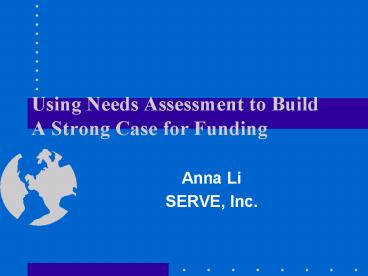Using Needs Assessment to Build A Strong Case for Funding - PowerPoint PPT Presentation
1 / 39
Title:
Using Needs Assessment to Build A Strong Case for Funding
Description:
... archival data and current wisdom demographics achievement scores census data current literature Data Collection Methods Survey Interviews Group Processes ... – PowerPoint PPT presentation
Number of Views:158
Avg rating:3.0/5.0
Title: Using Needs Assessment to Build A Strong Case for Funding
1
Using Needs Assessment to Build A Strong Case for
Funding
- Anna Li
- SERVE, Inc.
2
Purpose
- Why?
- How?
- Lessons learned
- Tips
3
Introduction
4
Definitions of Need
0
Current
Desired
State
State
MEANS
END
END
- the gap or discrepancy between a present state
(what is) and a desired end state (What should
be) - (Kaufman, Witkin Altschuld)
5
Definitions of Need
- Needs ¹ Demands ¹ Wishes ¹ Wants
6
Definitions of Need
- Need as a verb What is required or desired to
fill the discrepancy - solutions, means to end
7
What is a Needs Assessment?
- a systematic set of procedures undertaken for the
purpose of setting priorities and making
decisions about program or organizational
improvement and allocation of resources. The
priorities are based upon identified needs.
(Witkin Altschuld)
8
What is NA?
- A tool for determining valid and useful problems
which are philosophically as well as practically
sound. (Kaufman English)
9
Why Conduct NA?
- Obtain valid and reliable information
- to build a case for funding (example)
- sets criteria for determine how best to allocate
resources - to get buy-in from the stakeholders
10
Why Conduct NA ?
- Regulations or laws mandates
- Resource allocation and decision-making
- assessing the needs of specific underserved
subpopulation - As a part of program evaluation
11
Levels of Needs - Stakeholders
- Level 1 service receivers students, teachers
- Level 2 Service providers and policymakers
teachers, SEAs, LEAs - Level 3 Resources or solutions buildings,
facilities, computers
12
Three-Phase NA
- Preassessment - Exploration
- Assessment -Data Gathering
- Postassessment- Utilization
13
Preassessment
- to investigate what is already known
- to determine the focus and scope of the
assessment - to gain commitment for all stages of the
assessment
14
Secondary Data
- archival data and current wisdom
- demographics
- achievement scores
- census data
- current literature
15
Data Collection Methods
- Survey
- Interviews
- Group Processes
- Community Forum
- Nominal Group
- Focus Group
- Modified Delphi
16
Three Factors
- Time
- Resources (funding and personnel)
- Knowledge
17
Content of Technology NA
- skills, knowledge and attitudes
- access to information services
- staff development programs
- Inventory of Hardware and Software
- Technology support staffing
18
Content of Technology NA
- networking and telecommunication requirements
- budget and funding resources
- facilities
19
Interviews
- structured
- semi-structured
- open-ended
- face to face and telephone
- best for key informants
20
Focus Group
- group size 12-
- length of time 40 minutes to 3 hours
- best for information from select or homogeneous
groups
21
Sampling
- Simple Random Sampling
- Convenience Sampling
- Quota
- Interval
- Judgment
- Systematic
- Snowball
22
Quota
- Deciding on a fixed number of subjects with
particular characteristics - 25 male, 25 female
23
Interval
- Selection of subjects in periodic sequence e.g.
every 10th, or 25th
24
Systematic
- Used for a very large sample
- population/sample size n
- Choose every nth
25
Judgment Sampling
- Using the knowledge of experts to select a sample
- Disadvantage Subjective, could be biased
26
Snowball Sampling
- Starting with a small group and using them to
recruit others
27
Sample Size
- Desired accuracy sampling error
- Confidence level 95
28
Sampling Size Table
Sampling Error Sample Size Sampling Error Sample Size
1.0 10,000 5.5 330
1.5 4,500 6.0 277
2.0 2,500 7.0 204
2.5 1,600 7.5 178
3.0 1,100 8.0 156
3.5 816 8.5 138
4.0 625 9.0 123
4.5 494 9.5 110
5.0 400 10.0 100
29
SEIRTEC Needs Assessment Overview
- Faculty and Staff
- Young Child (K-3)
- Student Questionnaire (4th - 12th)
- Parent Questionnaire
- School Community Questionnaire
- Administrators Supplement
- Technical Supplement
30
Assessment
- Determine context, scope, and boundaries of NA
- Gather data on needs
- Set preliminary priorities on needs- Level 1
- Analyze and synthesize all data
31
Data Analysis
- statistical analysis
- coding qualitative data by themes or patterns
32
ReportingCommon mistakes
- not documenting findings
- not providing findings in useful formats
- not disseminating findings
33
Reporting Audience
- Founders
- Agency board
- Administrators
- Public or program/agency users
34
Reporting Contents
- Executive Summary
- Introduction
- Methods
- Results
- Discussions
- Conclusions and Recommendations
- References
35
Postassessment
- Set priorities on needs at all applicable levels
- Consider alternative solutions
- Develop an action plan to implement solutions
- Evaluate the NA
- Communicate results
36
Tips
- Ensure broad-based Stakeholder participation
- Choose appropriate means of data gathering
- Recognize core values in the group
- Make NA a participatory process
37
Tips
- Do not ignore political factors
- Make NA a decision-making process
- Make NA an on-going process
38
References
- Witkin, B. R. Altschuld, J. W. (1995). Planning
and conducting needs assessments, Sage
Publications. - Soriano, F. I. (1995). Conducting Needs
Assessments, Sage Publications.
39
Web Resources
- Http//www.seirtec.org/surveys
- http//www.ties.k12.mn.us/techplan/needs.html
- http//www.nctp.com/articles/assess.pdf































